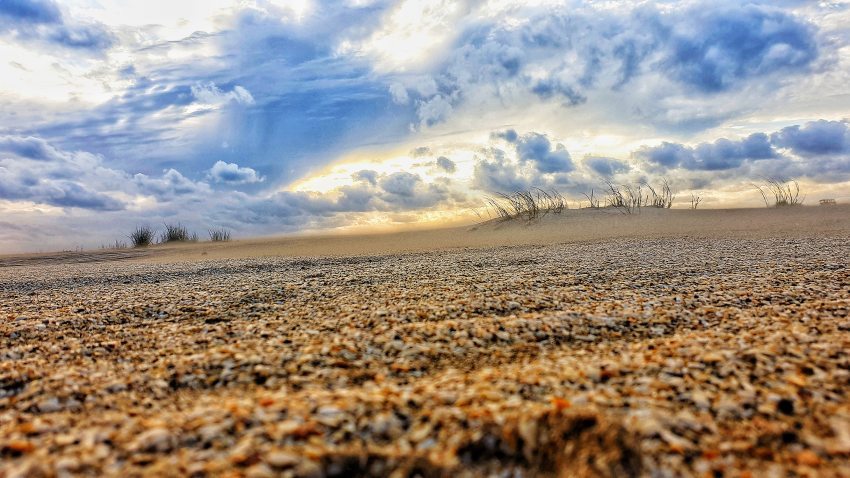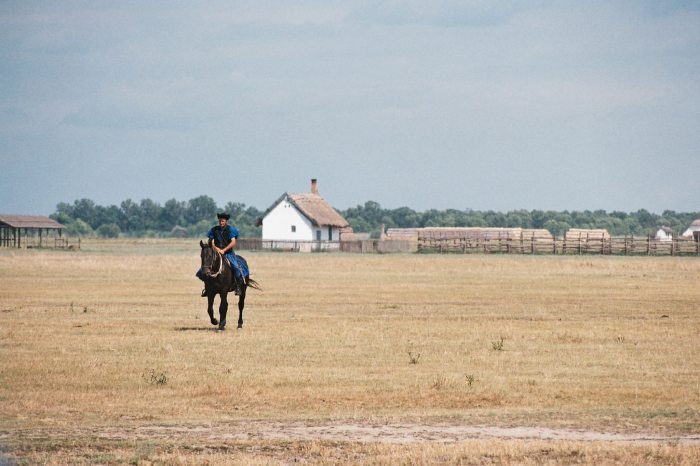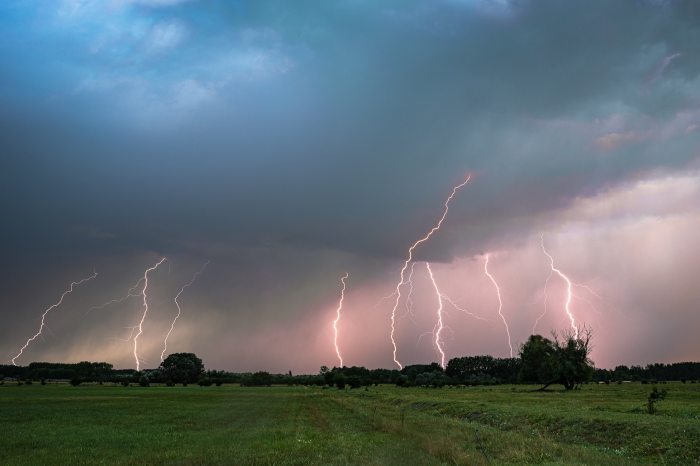If the Great Plain dries up, this is how it affects your life – "Some people see the need to change, and some people stick to the habit"
"People are tired of being frightened all the time, so say something cheerful and hopeful for a start!" – this is the kind of advice we get at the workshops we go to, mostly because we want our articles to be read. But while we are trying to figure out how to reach people with information, the Great Plain is drying up, not so nicely and not so slowly, and we are all feeling the effects of the change. In addition to the unbearable heat waves, agriculture is getting increasingly difficult, which could lead to a shortage of goods or even to people being less able to afford them. If you haven't given up reading despite the less-than-cheerful opening, I promise that we will try to find hope with geophysicist Gábor Timár and farmer Attila Szeredi by the end of this article.

Remember the summer of 2022? Sunflowers lined up lifelessly, their heads down, burnt out, the drought-cracked earth spread out beside them like forgotten ancient mosaics. It was a loud cry for help from Petőfi's endless prairie, and we refused to believe our ears and clung to the idea that we had 'just had a bad year'.
The Great Plain has always been a dry and hot region, but not as hot as now
Attila Szeredi still feels that the drought threat has not gone away. He has been working in the village of Kiszombor in the Great Plain for more than three decades: they have 1,100 hectares of farmland and 110 hectares of forest. They experienced the big change in 2022 when they saw that not enough water was being added to the soil and the moisture deficit was compounding because there was no rain. "In the past, we had these extremes, we had wet and dry years, but the soil didn't have the water deficit that it has now because now there is less water in the lower layers.
The drought is compounded by the fact that there is basically no winter, so we are under more pressure from both fungi and insects than in the weather we used to have.
In the past, we had a 20-30 mm rainfall zone across the country. Now we are seeing that these have become localized, with only a few millimeters falling in our areas in the Great Plain," the farmer concludes.
At such times, many of us tend to visualize the image of the shadoof on the Plain, and we just shrug, because, in our memories, the Great Plain has always been a dry and warm region of Hungary. But not as dry as it is now!
"When I was a kid, the summers were hot enough there, but now the 40-degree heat waves have become longer, and the brutal thing is that there is no relief," recalls Gábor Timár. According to the geophysicist, this is clearly due to climate change, and the river regulation of the early 19th century also contributed to the drying out of the Great Plain, as the floodplains are no longer flooded by the water from the Carpathians, mostly from snowmelt. Despite this, the geophysicist does not think that the regulation was a bad idea at the time since in the 19th century it was an important and achievable goal to convert the extensive marshlands into areas suitable for agriculture.
"Nobody expected that in 100-120 years' time, this would reduce the adaptability of the landscape in a climate change nobody knew was coming," the scientist stresses.
With sufficient rainfall, this would not be such a problem, but the rain hasn't come for years. And one of the main reasons for this is not to be found in the sky, but in the ground, or more precisely in the soil and the way we cultivate it.
April showers bring May flowers
In Hungarian, this saying goes, "May rain is worth gold". According to Gábor Timár, this is why the May rains are worth double gold this year because if we turn to June with dusty, dry soil, that could be even more serious than the drought of 2022. The usual rainy period at the beginning of June can be triggered by cold fronts, but the heavy rain usually comes when thunderstorms develop as a result of the ground-level moisture, the rapid rise in air temperature due to high daytime peak temperatures or fronts, and the 'swirling' effect of wind direction changing with altitude. However, ground-level moisture is increasingly absent from the picture, partly as a consequence of soil depletion through soil tillage.
"There used to be a wetland here, with a different soil structure and vegetation covering the land. You have to think of it a bit like a swamp. The water was stored in the soil, there under the leaves of the marsh vegetation. If you start plowing this with heavy machinery, which digs up the soil about a couple of inches or so, you create what's called a ploughshare surface, which you also compact every year, so it acts as a barrier layer.
Before this, the top two meters of soil used to store water easily, but now only about 25 centimeters is suitable. Since wheat, maize, and sunflowers cannot completely shade the soil, the upper layers dry out quickly during summer heat waves.
And when large amounts of rain fall on the ground in a short period of time, the ploughshare layer also prevents the ground from absorbing the water and inland flooding occurs," says the geophysicist.
According to Attila Szeredi, soil degradation is the result of the last 60 years, and recovery takes a long time. He sees that there have been some positive developments, for example, conferences on "no-till" or "min-till", i.e. crop production technologies that partially or completely abandon soil cultivation, but farmers are still forced to go their own way. "Some farmers are open, receptive and see the need for change, but there is also a part of farmers who are not and keep doing everything by habit," he adds.
No-tillage, re-greening, biodiversity enhancement
The Soil Restoration Farmers Association, of which he is a member, seeks to disseminate and share farming knowledge and practical experience that physically and chemically reduce the impact on the soil and increase its organic matter content. At the same time, I have spoken to several farmers who would like to have centralized retraining opportunities where they can access science-based information. Others are completely put off because "the forced, subsidy-linked practice of re-greening has also set very bad examples in their area" and they believe that "greening is more of a business than an environmentally conscious mission".
Attila Szeredi agrees that no-till is not a cure-all for every problem, but it can definitely improve the situation. "In addition, there is a great need for change above the soil surface, as a large percentage of the country's land is sown with grain and oilseed crops. We produce minimal other crops that would increase biodiversity, and we have little manure to return to the soil, which we are trying to replace with artificial fertilizers," the farmer concludes.
Gábor Timár believes that it would be important to model where and in what distribution it would be worthwhile to reforest certain areas to restore the field for storms. In his opinion, this would not be such a big blow to the economy, as there is plenty of land that is not of good enough quality to produce a large harvest.
"In terms of water management, we believe that reforestation can bring good results, and we believe that sooner or later the support system will move in this direction."
" Out of four million hectares of arable land, one million are certainly areas with unfavourable conditions. We should give them all back to nature, and there is a professional argument for doing so, and I think that sooner or later this will be forced out of the system," says the farmer.
Good practices do not work immediately
The geophysicist points out that whatever we do, we have to take into account that on a global scale, the Earth has about 20-25 years of inertia, which means that if we were to return to the emission levels of the 1800s (which is not going to happen now), it would still be 20 years before we would notice that anything had happened to the climate.
Both Attila Szeredi and Gábor Timár agree that real change can only be achieved through top-down measures. Politicians need to be persuaded to pay attention to the Great Plain, and in addition to a general emphasis on climate protection, a system needs to be developed that allows farmers to return land that is not of very good quality to nature, without their livelihoods being at risk.
It would also be important to reform agricultural education so that the transfer of knowledge to future farmers would not be the individual action of an open-minded educator, but a systemic transfer of knowledge. We, the lay public, can participate in change not only through our electoral behaviour, but also through our conscious choices, which are not just about taking an environmentally friendly action, but about radically changing our way of thinking, passing it on, and answering the question in our everyday lives: "What can I do today for my environment?"









